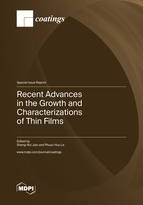Recent Advances in the Growth and Characterizations of Thin Films
A special issue of Coatings (ISSN 2079-6412). This special issue belongs to the section "Thin Films".
Deadline for manuscript submissions: closed (20 September 2022) | Viewed by 35160
Special Issue Editors
Interests: nanoindentation; thin film properties; microstructural analysis; molecular dynamics simulations; high-pressure physics; high-temperature alloy
Special Issues, Collections and Topics in MDPI journals
Interests: thermoelectric thin films; topological insulator materials; thin film growth technique; structural analysis
Special Issues, Collections and Topics in MDPI journals
Special Issue Information
Dear Colleagues,
We would like to invite you to submit your work to a Special Issue on “Recent Advances in the Growth and Characterizations of Thin Films”. To achieve the desired properties of thin films, it is essential to optimize the processing parameters/conditions to control thin-film growth with physical and chemical methods, such as molecular beam epitaxy (MBE), pulsed laser deposition (PLD), magnetron sputtering, thermal evaporation, ultrasonic spray pyrolysis (USP), chemical vapor deposition (CVD), etc. Thermoelectric (TE), topological insulator (TI), metal oxide (MO), multiferroic, and semiconductor thin films are great topics of interest for fundamental studies and device applications. The characterization of a typical thin film sample could include the clarifications of crystal structures (XRD, HRTEM), morphology (AFM, SEM), composition–stoichiometry (EDS, XPS), electrical and magnetotransport properties (Hall effect, PPMS), the Seebeck coefficient, optical (UV-visible, PL, Raman spectroscopy), magnetic (SQUID), and mechanical properties (nanoindentation), and ultrafast carrier and phonon dynamics (time resolved pump-probe spectroscopy).
The aim of this Special Issue is to provide a snapshot of the state-of-the-art in thin-film growth and characterizations of TE, TI, MO, multiferroic, and semiconductor thin films and their applications.
In particular, the topics of interest include but are not limited to
- Progress in thin-film growth and characterization techniques;
- Processing condition–structure–property relations;
- Nanomechanical properties of thin films via the advanced nanoindentation technique;
- Structural, morphological, optical, electrical, magnetic and thermoelectric properties of thin films;
- Magnetotransport properties and ultrafast carrier and phonon dynamics of topological insulators;
- Photocatalytic degradation of pollutants and PEC activity of metal oxides;
- Theory and modeling of the physical properties of thin films.
Prof. Sheng-Rui Jian
Dr. Phuoc Huu Le
Guest Editors
Manuscript Submission Information
Manuscripts should be submitted online at www.mdpi.com by registering and logging in to this website. Once you are registered, click here to go to the submission form. Manuscripts can be submitted until the deadline. All submissions that pass pre-check are peer-reviewed. Accepted papers will be published continuously in the journal (as soon as accepted) and will be listed together on the special issue website. Research articles, review articles as well as short communications are invited. For planned papers, a title and short abstract (about 100 words) can be sent to the Editorial Office for announcement on this website.
Submitted manuscripts should not have been published previously, nor be under consideration for publication elsewhere (except conference proceedings papers). All manuscripts are thoroughly refereed through a single-blind peer-review process. A guide for authors and other relevant information for submission of manuscripts is available on the Instructions for Authors page. Coatings is an international peer-reviewed open access monthly journal published by MDPI.
Please visit the Instructions for Authors page before submitting a manuscript. The Article Processing Charge (APC) for publication in this open access journal is 2600 CHF (Swiss Francs). Submitted papers should be well formatted and use good English. Authors may use MDPI's English editing service prior to publication or during author revisions.
Keywords
- thin-film growth techniques
- thin films and nanostructured coatings
- materials processing and properties
- structural analysis
- molecular dynamics simulations







